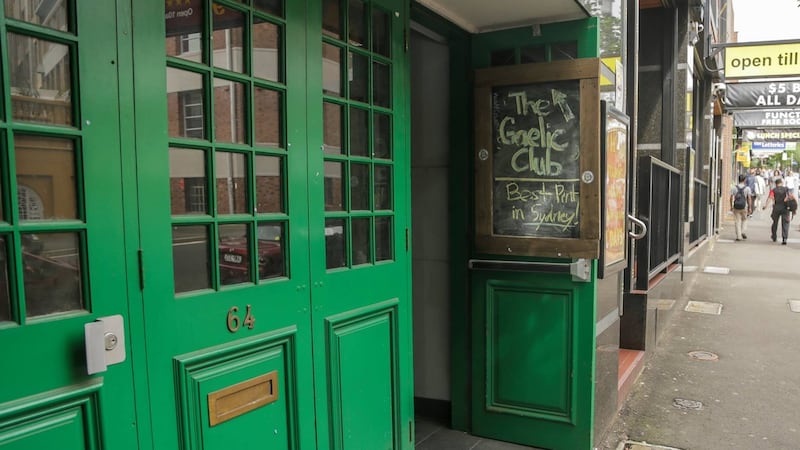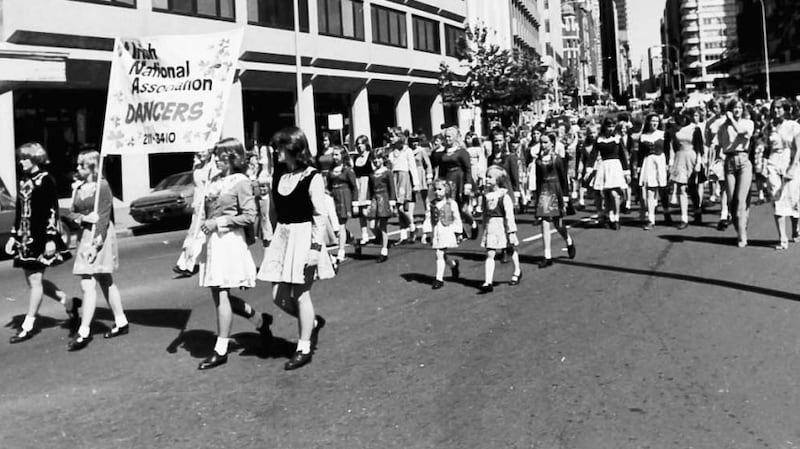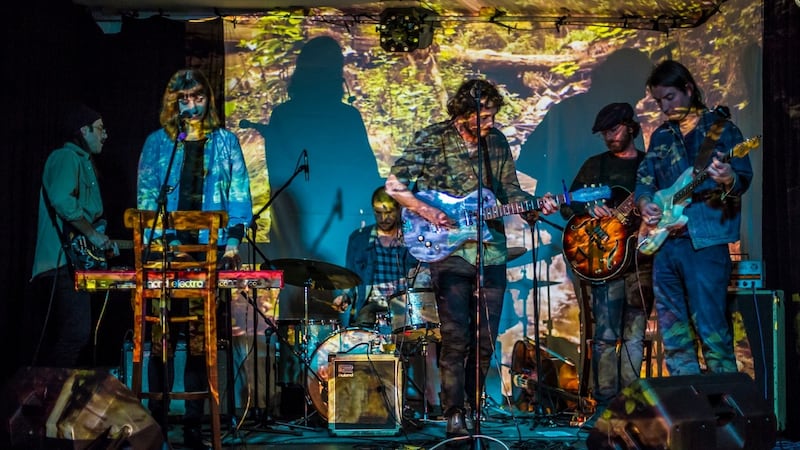Some things in the city of Sydney are constants. The gleaming sea, the span of the harbour bridge, the bright, cleansing sunshine of the summer months, the surfers bobbing on the swell off Bronte beach.
And some elements of the city are constant only in how regularly they cycle through change: older buildings making way for newer ones, the urban landscape vying to share the stage with the beautiful natural one; communities arriving, growing, succeeding and moving onwards, upwards, outwards.
As a building and a community hub, Sydney’s Gaelic Club stands unique.
In the inner city suburb of Surry Hills, the entrance to 64 Devonshire Street is marked by a pair of green doors and a plaque, describing it as the Patrick Pearse Branch of the Irish National Association (INA).

The Gaelic Club is most often described by those who use it as more of a community centre than anything else. It certainly has a parish hall atmosphere. Heading up the two flights of stairs to the venue on the top floor, the staircase is lined by framed jerseys from the 32 counties. The main room is a large, rectangular space. One half is carpeted, with chairs, tables, couches and a small bar. The other half is a dance floor, with a stage. The walls and roof are painted a colour that could only be described as Galway maroon.
Entering the main function room, a sound familiar to many Irish childhoods - of a fiddle played very, very badly - is coming in fits and starts from a side room. Music lessons on Tuesday nights, explains Karl Kinsella, the INA’s current president.
There is a fairly regular schedule of events at the Club these days. On Mondays there are Irish language classes, on Tuesdays the music lessons (mostly beginners if what I hear is anything to go by), Thursdays is for a discussion group called Politics in the Pub, and on Saturday mornings, the Club has been host to the Dwyer-Whelan Academy of Irish Dancing for the past 50 years.
Assisted Passage
The Gaelic Club dates from 1955, when the INA purchased a row of terraced houses, knocked them and built the Irish Cultural Centre. Formed by Albert Dryer, born in Sydney in 1888 of German-Irish parents, one of the INA’s key objectives is “to foster an Irish spirit” - a goal both moving and somewhat overwhelming in its simplicity.

In the 1940s and 50s, there was plenty of Irish spirit to be found in Sydney. Irish emigration had reached levels only previously seen in the aftermath of the Famine. More than half a million people left Ireland between 1945 and 1960. The Assisted Passage scheme - known as the "Ten Pound Poms" scheme after the price migrants from the UK and Ireland paid for subsidised travel to Australia or New Zealand - ensured that most not headed for Britain or the US found themselves going down under.
Weekend Irish dances at the Club in the 1940s and 50s are now legendary, fondly remembered by hundreds if not thousands of Irish-Australians who met their partners there, romance blossoming during sets of the Siege of Ennis.
The Club has seen different phases and incarnations through the decades. Through the 1960s, the club hosted “housie" or “bingo” sessions for locals to raise money to pay off the loan on the building. In the late 1960s, a licensed club was opened on the premises.

As Jimmy Mullarkey, a regular musician at the club in the 70s, remembers, “it was the only place to go then, there was no Irish pubs around as such like there is nowadays. There’d be a band playing there, and there’d be a band playing upstairs as well and you’d kind of go between the two … to try and chase a few women!”
Through the 1980s, other establishments that drew a strong Irish crowd were opening in Sydney, but the Club had a late licence and so continued to attract the crowds.
‘Misfits’
Tina King Garde arrived to Sydney in 1981. She walked into the Gaelic Club at 18 looking for a job, and worked in the bar, on and off, for the next 17 years. She particularly rememebers the massive Sunday nights.
“We had the Irish Drovers, Shindig, Jimmy Mullarkey… the Chieftans played here on their tour. We had a late licence so it was usually great Craic, but it was also a mad house between 10pm and 12.30am. I remember a raid one night and there being 17 squad cars outside the door!
“In the 60s and 70s it had been all about the dances. But in those days, the 80s, it was a place for the misfits. Irish people, mostly men, came over on their own, with no connections and it was hard to make connections. They wandered in for company, and the Gaelic Club was the place you went to, to get a job, to have a chat, to just feel at home.”

Kinsella remembers the same atmosphere. “I came over from London in the early 1990s, and hung out at the Club for the cultural side of things really. I was a musician and interested in meeting other musicians. At the time, to me the place seemed full of people who were lamenting their status as emigrants, pining for home. I wasn’t interested in that, but I suppose now I understand it better.”
Throughout the 90s and 2000s the Club persevered, although with mixed fortunes. An attempted renovation didn’t go so well. Advancing technology changed the nature of how people connect and communicate, which also posed a significant challenge.
Today, the events listings on the Club’s Facebook page is an intriguing mix; everything from trad music sessions, concerts by visiting Irish musicians, and pop-up Gaeltachts, to gigs, album launches and DJ sets from up and coming Sydney performers with no Irish connections at all.
Dylan Robinson, bar manager and audio engineer, explains that the Gaelic Club will always be a space for the community first. Because the Club is ultimately a commercial entity, the management must also try and use the space to turn a profit.
“Sadly, with the lock-out laws taking a huge toll on late night venues in Sydney,” he says, referencing controversial laws introduced in 2014 which forbid venues from permitting entry after 1.30am.
“This is one of the only spaces left in the city for up and coming performers to play.”
Sydney Queer Irish
It is now also the home of Sydney Queer Irish (SQI), the city's Irish LGBTQI+ group (facebook.com/SQIrish/). Its founder Loretta Cosgrove knew the Gaelic Club from her childhood in Sydney in the 80s.

“At the time, it was the absolute heart and soul of all community celebrations. I remember going up the stairs on St Patrick’s Day and that feeling of it just being packed with people we knew. I hadn’t been there in years, but when Sydney Queer Irish started to take off, we needed a space that was for us, that we could use how we wanted. We’ve used the Club for our committee meetings, for our marriage equality party, our post Mardi Gras parties.
“It’s a space that’s there for us, as Irish people, in the way that somewhere else could never be. I think it’s an incredible asset for the community. I hope that through SQI I’ve exposed a new generation of Irish people to the club, and I’m proud of that.”
One of those people is the Gaelic Club’s current president, Patrick Scahill, who first became aware of the venue when he attended a SQI party at the Club to watch the results of the Irish marriage equality referendum in 2015, which happened to coincide with the Eurovision.
“We had an amazing night in here,” he recalls. “I’ve been involved since.
Future plans
Kinsella’s intention is to use the Club much more to expand the general mission of the Irish National Association, which is the promotion of Irish culture. Sitting in the library, located just off the function room, he talks about the history of the venue. The library is musty, but steeped, literally and metaphorically, in the history of the organisation and by extension, the community in Sydney. The board table is engraved with Celtic crosses, and the walls and the floor are lined and stacked with books, many donated by Eamon de Valera.
“People make the mistake of comparing the Gaelic Club to other Irish bars. That’s missing the point. An Irish bar can be created with few Guinness posters on the wall and Irish stew on the menu, but that doesn’t make it an Irish space. What makes this place is the authenticity. That can’t be replicated.”
Kinsella, Scahill and their colleagues are all in agreement about the future of the space. They’d like to see it used more, and it needs a facelift. It’s in a prime location, but empty all day during the week. The hope is that a light refurbishment will allow the Club to be used as a flexible working space, or by mother and baby groups, or some of the other varied community groups in Sydney.
“Definitely the best nights in here are when the Irish community comes together to celebrate something,” says Scahill. “Watching people come together, the community reminiscing, staying late and sharing stories. That’s what it’s all about, ultimately.”
In dynamic Sydney, an enduring space that’s unmistakably “ours” is a rare and valuable thing. The Gaelic Club still has its place.











